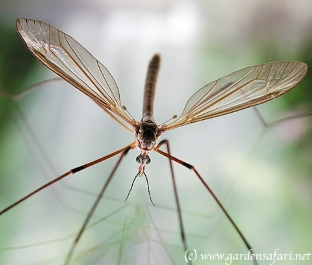Interactions
The Crane Flies’ interaction with other species
has a lot to do with the habitat that it resides in. The larvae
of the Tipulaidae are found in moist soil, in wet places along
bodies of water, and in decaying leaves and organic matter in
wooded areas. They tend to reside in habitats that have lots of
moisture. See Habitat page for more information.
Most of the Tipulaidae interactions are with aquatic vegetation
or vegetation that is found near bodies of water. Some species
are pests of sod grasses, grains, and other cultivated plants.
(Allen 2003).

Typically, Crane Flies are food to other animals such as frogs,
fish, birds, lizards, spiders, and even other insects. The
larvae of the Crane Fly serve as an important role in the food
chain. Not only as a source of food, but also in enriching the
soil for other species. The larvae are detritus feeders which
mean the larvae break down organic matter in streams and on the
forest floors. This is important for other organisms that will
need these nutrients (Red Planet Inc. 2012).
As stated in the (nutrition) page, many
species of crane flies are hosts to pseduoscorpians and mites.
There has also been evidence to suggest that many species from
the Family Tipulidae have been victims of the parasitic
fungus Entomophthora. When infected, the fly shows off a bloated
abdomen filled with visible spores that eventually leads to
death (Young 2008) .
To Return Home
Continue to Gallery